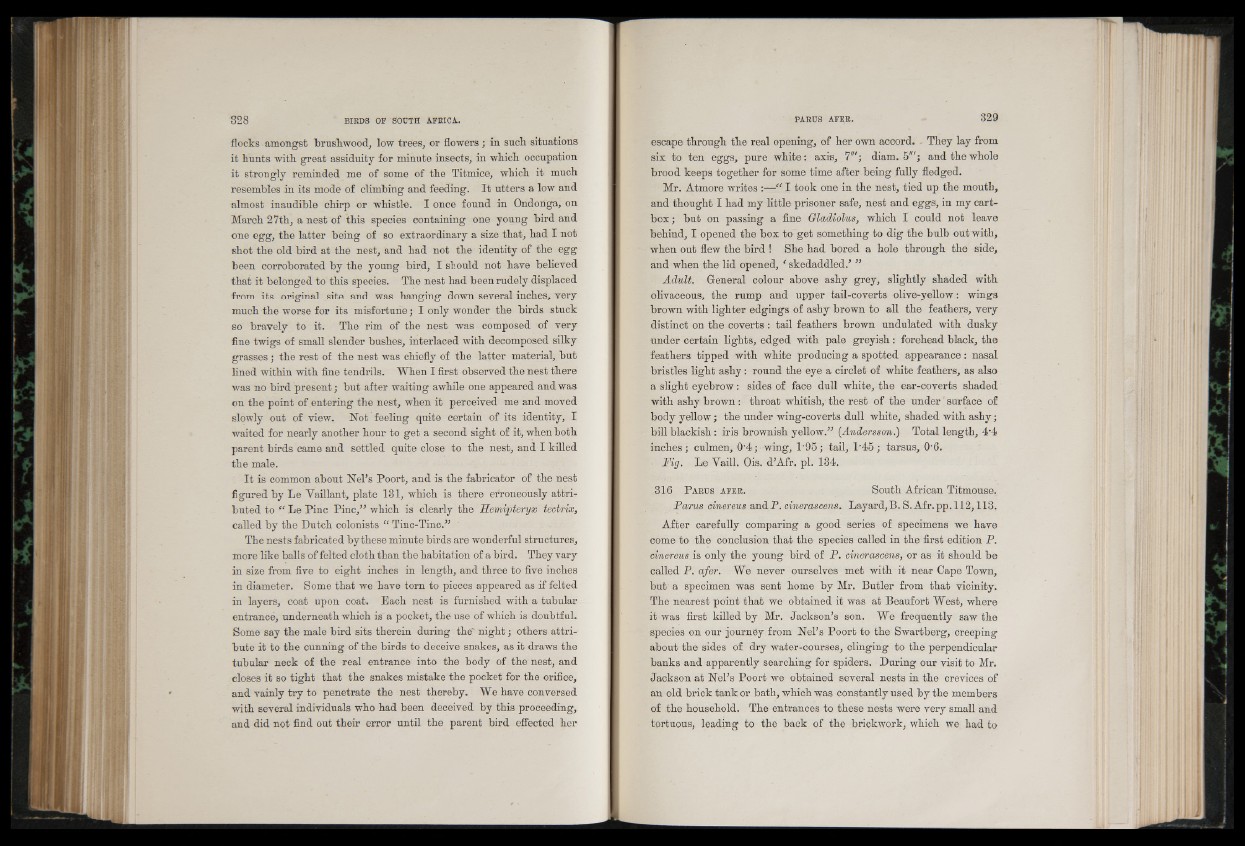
flocks amongst brushwood, low trees, or flowers ; in such situations
it hunts with great assiduity for minute insects, in which occupation
it strongly reminded me of some of the Titmice, which it much
resembles in its mode of climbing and feeding. It utters a low and
almost inaudible chirp or whistle. I once found in Ondonga, on
March 27th, a nest of this species containing one young bird and
one egg, the latter being of so extraordinary a size that, had I not
shot the old bird at the nest, and had not the identity of the egg
been corroborated by the young bird, I should not have believed
that it belonged to this species. The nest had been rudely displaced
from its original site and was hanging down several inches, very
much the worse for its misfortune; I only wonder the birds stuck
so bravely to it. The rim of the nest was composed of very
fine twigs of small slender bushes, interlaced with decomposed silky
grasses; the rest of the nest was chiefly of the latter material, but
lined within with fine tendrils. When I first observed the nest there
was no bird present; but after waiting awhile one appeared and was
on the point of entering the nest, when it perceived me and moved
slowly out of view. Not feeling quite certain of its identity, I
waited for nearly another hour to get a second sight of it, when both
parent birds came and settled quite close to the nest, and I killed
the male.
It is common about Neks Poort, and is the fabricator of the nest
figured by Le Yaillant, plate 131, which is there erroneously attributed
to “ Le Pine Pine,” which is clearly the Hemijpteryx tectrix,
called by the Dutch colonists “ Tinc-Tinc.55
The nests fabricated by these minute birds are wonderful structures,
more like balls of felted cloth than the habitation of a bird. They vary
in size from five to eight inches in length, and three to five inches
in diameter. Some that we have tom to pieces appeared as if felted
in layers, coat upon coat. Each nest is furnished with a tubular
entrancé, underneath which is a pocket, the use of which is doubtful.
Some say the male bird sits therein during the" night; others attribute
it to the cunning of the birds to deceive snakes, as it draws the
tubular neck of the real entrance into the body of the nest, and
closes it so tight that the snakes mistake the pocket for the orifice,
and vainly try to penetrate the nest thereby. We have conversed
with several individuals who had been deceived by this proceeding,
and did not find out their error until the parent bird effected her
escape through the real opening, of her own accord. They lay from
six to ten eggs, pure white: axis, 7"'; diam. 5"'; and the whole
brood keeps together for some time after being fully fledged.
Mr. Atmore writes :—“ I took one in the nest, tied up the mouth,
and thought I had my little prisoner safe, nest and eggs, in my cart-
box; but on passing a fine Gladiolus, which I could not leave
behind, I opened the box to get something to dig the bulb out with,
when out flew the bird ! She had bored a hole through the side,
and when the lid opened, ‘ skedaddled.5 55
Adult. General colour above ashy grey, slightly shaded with
olivaceous, the rump and upper tail-coverts olive-yellow: wings
brown with lighter edgings of ashy brown to all the feathers, very
distinct on the coverts : tail feathers brown undulated with dusky
under certain lights, edged with pale greyish: forehead black, the
feathers tipped with white producing a spotted appearance: nasal
bristles light ashy: round the eye a circlet of white feathers, as also
a slight eyebrow: sides of face dull white, the ear-coverts shaded
with ashy brown: throat whitish,- the rest of the under surface of
body yellow; the under wing-coverts dull white, shaded with ashy;
bill blackish: iris brownish yellow.55 (Andersson.) Total length, 4'4
inches; culmen, 0'4; wing, L95; tail, 1‘45; tarsus, 0'6.
• Fig. Le Yaill. Ois. d5Afr. pi. 134.
316 P arus a f e r . South African Titmouse.
Parus cinereus andP. cinerascens. Layard,B. S.Afr.pp.112,113.
After carefully comparing a good series of specimens we have
come to the conclusion that the species called in the first edition P.
cinereus is only the young bird of P. cinerascens, or as it should be
called P. afer. We never ourselves met with it near Cape Town,
but a specimen was sent home by Mr. Butler from that vicinity.
The nearest point that we obtained it was at Beaufort West, where
it was first killed by Mr. Jackson5s son. We frequently saw the
species on our journey from Neks Poort to the Swartberg, creeping
about the sides of dry water-courses, clinging to the perpendicular
banks and apparently searching for spiders. During our visit to Mr.
Jackson at Neks Poort we obtained several nests in the crevices of
an old brick tank or bath, which was constantly used by the members
of the household. The entrances to these nests were very small and
tortuous, leading to the back of the brickwork, which we had to